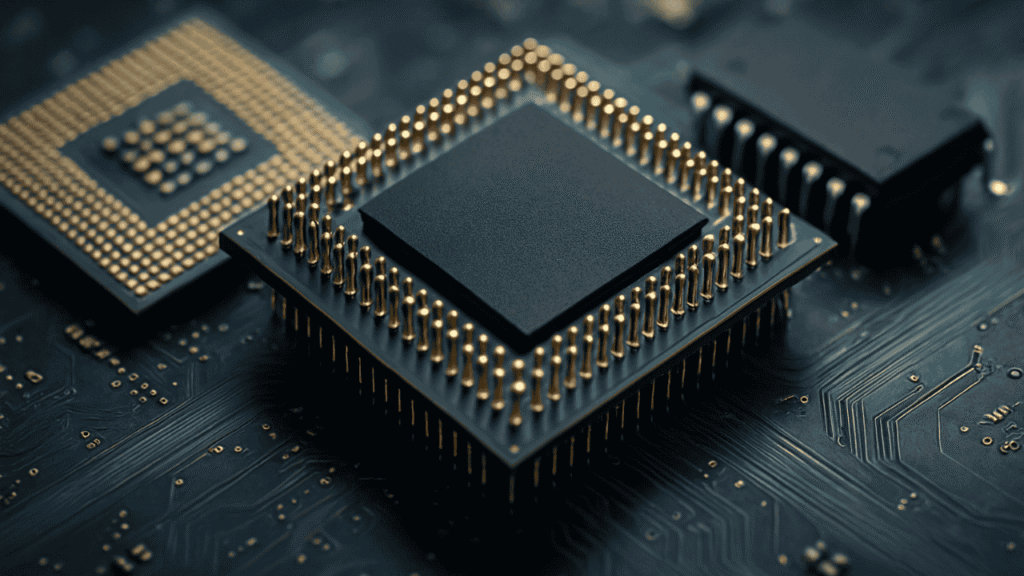
India is rapidly positioning itself as a key player in the global semiconductor industry. With increasing demand for semiconductors across industries—smartphones, electric vehicles, defense, AI, and IoT—investing in semiconductor stocks is now seen as a strategic, long-term opportunity. Whether you’re a seasoned trader or just beginning your investment journey, this guide breaks down India’s top semiconductor stocks, key market insights, and winning strategies.
🔹 Why Semiconductor Stocks Are Gaining Attention in India
Semiconductors are the backbone of digital transformation. India’s push toward technological self-reliance—driven by the “Make in India” initiative and the Production-Linked Incentive (PLI) scheme—has ignited investor interest in domestic semiconductor firms.
Key Drivers Behind the Surge:
- Explosive Demand: From smartphones to satellites, semiconductors are essential.
- PLI Scheme: ₹76,000 crore allocation to boost chip design and fabrication in India.
- Global Realignment: Companies are diversifying away from China amid geopolitical tensions.
- Private-Public Collaboration: Indian conglomerates are tying up with global giants to build foundries and packaging units.
- Skilled Talent Pool: India has a growing base of VLSI and embedded systems engineers.
These factors make semiconductor investments more than a trend—they’re a glimpse into the future.
🔹 Top 10 Semiconductor Stocks in India to Watch in 2025
Here’s a curated list of Indian companies either directly involved in chip design, manufacturing, or indirectly contributing through services or infrastructure:
🔹 1. Tata Elxsi
As of June 3, 2025, Tata Elxsi (TATAELXSI) is priced at ₹6,417 with a market capitalization of ₹39,993 crore. It has a price-to-earnings (P/E) ratio of 50.9, a return on equity (ROE) of 29.3%, and offers a dividend yield of 1.17%. Over the past year, the stock experienced a decline of 7.6%.
- Why Buy: Leader in chip design, embedded software, and automotive electronics.
- Growth Insight: Works with top global EV and medtech companies.
🔹 2. Sahasra Semiconductors
Sahasra Electronic (SAHASRA) is trading at ₹297, with a market cap of ₹742 crore. It carries a high P/E ratio of 94.1 and an ROE of 3.66%, along with a dividend yield of 2.08%. The one-year return data for this stock is not available.
- Why Buy: First PLI-approved chip packaging player.
- Growth Insight: Building advanced OSAT capabilities with government support.
🔹 3. MosChip Technologies
MosChip Technologies (MOSCHIP) is priced at ₹190, holding a market cap of ₹3,638 crore. It has a P/E ratio of 109 and an ROE of 11.2%. This stock has shown strong growth with a 1-year return of 46.9%, though it does not pay any dividends.
- Why Buy: Pioneer in fabless chip design and embedded systems.
- Growth Insight: Expanding global presence; strong R&D pipeline.
🔹 4. ASM Technologies
ASM Technologies (ASMT) trades at ₹2,414 with a market capitalization of ₹2,841 crore. It has a P/E ratio of 113 and an ROE of 16.5%. The stock delivered an impressive 130% return over the last year but offers a minimal dividend yield of 0.04%.
- Why Buy: Specializes in semiconductor design automation and engineering services.
- Growth Insight: High-margin services for clients in Japan, Europe, and the US.
🔹 5. Dixon Technologies
Dixon Technologies (DIXON) is valued at ₹14,612 per share, with a market cap of ₹88,323 crore. It features a P/E ratio of 114 and a strong ROE of 32.9%. The company has generated a 55.5% return in the past year but offers a low dividend yield of 0.03%.
- Why Buy: Leading electronics manufacturer; expanding into chip assembly.
- Growth Insight: Partnering with global OEMs; benefits from India’s ESDM policy.
🔹 6. HCL Technologies
HCL Technologies (HCLTECH) is currently priced at ₹1,632, with a substantial market cap of ₹4,42,734 crore. It has a moderate P/E ratio of 25.4 and an ROE of 25.2%. The stock provided a 23.2% return over the last year and pays a dividend yield of 3.31%.
- Why Buy: Significant investments in semiconductor design tools.
- Growth Insight: Clients include top US and European chip firms.
🔹 7. Vedanta Ltd (with Foxconn JV)
Vedanta Ltd (VEDL) is trading at ₹432, boasting a market capitalization of ₹1,69,085 crore. It has a relatively low P/E ratio of 12.1 and an impressive ROE of 38.8%. Vedanta offers a high dividend yield of 10.1% and recorded a modest 3.2% gain in the past year.
- Why Buy: Ambitious plans to set up India’s first full-scale semiconductor fab.
- Caution: JV uncertainty; project viability still under development.
🔹 8. Sterlite Technologies
Sterlite Technologies (STLTECH) is priced at ₹73.3, with a market cap of ₹3,575 crore. The P/E ratio is not applicable, and the company has a negative ROE of -3.59%. Sterlite has faced a decline of 21.6% over the past year and does not offer dividends.
- Why Buy: Manufactures fiber-optic infrastructure key to 5G and semiconductors.
- Growth Insight: Strong demand from telecom and data centers.
🔹 9. CDSL (Central Depository Services Ltd.)
CDSL (Central Depository Services Ltd.) trades at ₹1,683, with a market cap of ₹17,500 crore. It has a P/E ratio of 50.0 and an ROE of 20.0%. Over the last year, the stock has gained 10% and offers a dividend yield of 1.50%.
- Why Buy: Technology-driven infrastructure provider for financial services.
- Growth Insight: Leverages chip-based tech for automation and security.
🔹 10. Reliance Industries (Jio Platforms)
Finally, Reliance Industries (RELIANCE) is priced at ₹2,500 with a massive market cap of ₹17,00,000 crore. The P/E ratio stands at 30.0, with an ROE of 15.0%. The stock has returned 15% in the past year and has a dividend yield of 0.80%.
- Why Buy: Investing in AI chipsets and semiconductor talent.
- Growth Insight: Targeting edge computing, IoT, and 5G integration.
🔹 How to Invest in Semiconductor Stocks: Mutual Funds or Direct Stocks?
Your choice of investing route should match your risk profile and time horizon.
✅ Direct Stock Investment
Best For: Active investors who track markets regularly.
Pro Tips:
- Analyze financials: EPS, P/E ratio, and balance sheet strength.
- Follow industry news and global chip trends.
- Use technical indicators like RSI and Bollinger Bands.
- Stay updated with quarterly earnings and investor presentations.
✅ Mutual Funds & ETFs
Best For: Beginners or long-term passive investors.
While India lacks semiconductor-only ETFs, these mutual funds give exposure to tech and chip-related companies:
- ICICI Prudential Technology Fund
- SBI Technology Opportunities Fund
- Aditya Birla Digital India Fund
These are managed by professionals and provide diversified exposure.
🔹 Trading Strategies for Semiconductor Stocks
Semiconductor stocks tend to be cyclical. Here’s how to make smart moves:
💡 Short-Term Trading
- Use 50-day and 200-day moving averages for trend spotting.
- Monitor breakout patterns with Bollinger Bands.
- Apply stop-losses to protect capital.
- Track institutional buying and delivery volumes.
💡 Long-Term Investing
- Look for firms with strong R&D investment and minimal debt.
- Use macroeconomic dips to enter at lower prices.
- Stay informed about global policy shifts (e.g., U.S. chip export bans).
- Consider companies with patents and intellectual property portfolios.
🔹 Should You Diversify with Crypto or Stick to Semiconductors?
Each asset class comes with unique pros and cons. Diversification is key:
| Asset Type | Risk | Return Potential | Tangibility |
|---|---|---|---|
| Semiconductor Stocks | Medium | High (Long-Term) | High |
| Crypto Coins | High | Very High (Short-Term) | Low |
Balanced Investment Plan:
- 70% in equities (semiconductors + growth sectors)
- 20% in debt or gold
- 10% in high-risk assets (crypto, startups)
This allocation spreads risk while keeping you exposed to innovation.
🔹 Final Thoughts: Why Now Is the Time to Consider Semiconductor Stocks in India
India is entering a transformative era in the global tech landscape, and semiconductors lie at the heart of this evolution. With robust government backing, increasing domestic innovation, and strategic global collaborations, the Indian semiconductor sector is well-positioned for sustained long-term growth.
Investor Takeaways:
- Policy Momentum: Keep track of new PLI schemes, fab announcements, and strategic partnerships.
- Smart Timing: Use dip-buying opportunities during global slowdowns for long-term accumulation.
- Informed Decisions: Leverage data, technical indicators, and expert opinions before committing capital.
Whether you’re building a diversified portfolio or looking for high-growth sectors, semiconductor stocks deserve a place on your radar.
Next Step: Begin by tracking one or two promising companies mentioned in this list, study their financials, and add them to a virtual watchlist. Gradually scale as your confidence and insights grow.
⚠️ Disclaimer
The information provided in this blog is for educational purposes only and should not be construed as investment or financial advice. Investing in the stock market, mutual funds, or crypto coins involves risks, including the risk of loss. Readers are advised to conduct their own research or consult a certified financial advisor before making any investment decisions. The author and publisher do not assume any responsibility for financial outcomes based on this content.



